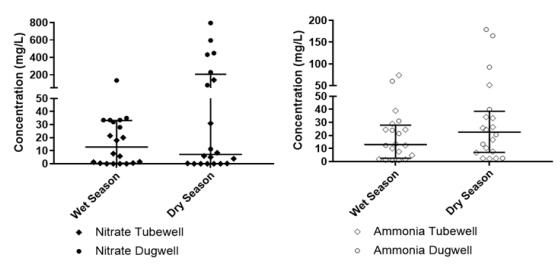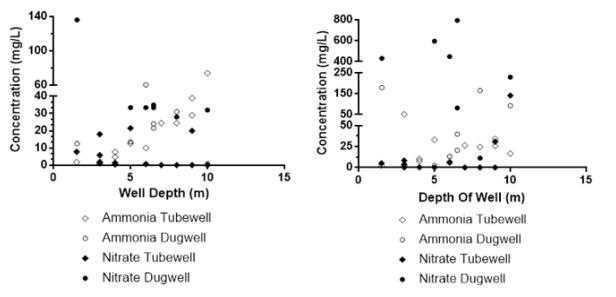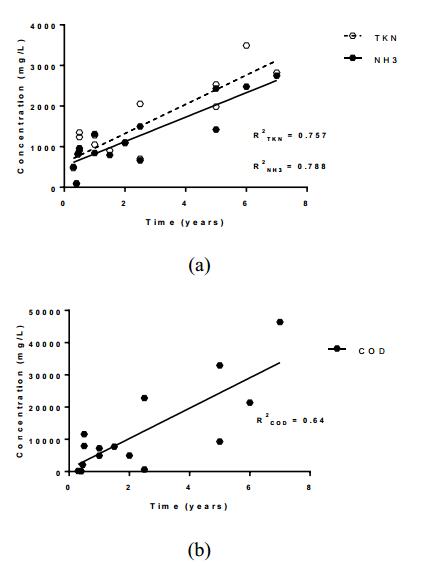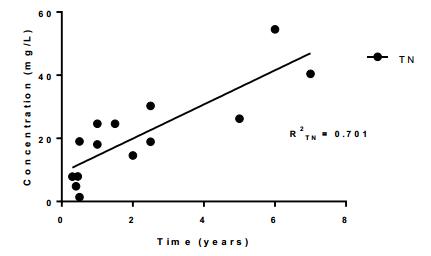1. Introduction
Pit latrines are the most common form of on-site sanitation in low-income countries. They typically consist of a dug pit covered with a slab and a squatting hole which serves to isolate human excreta. While basic, they meet the minimum requirements of improved on-site sanitation [1]. There are, however, concerns about the leaching of chemical pollutants such as ammonia and nitrate from pit latrines and septic tanks into nearby groundwater. This may pose serious health risks, given that groundwater is often a significant source for drinking water. Normally, in the effluent of pits and septic tanks, nitrogen will be in the form of ammonia or organic nitrogen, before potentially nitrifying into nitrate [2]. Factors affecting nitrogen levels in groundwater include soil properties, the groundwater level, precipitation, the location of water abstraction points and population density. Leaching nutrients undergo numerous transformations in groundwater depending on hydro-geochemical conditions, which also affect the transport of these species. Nitrate is considered mobile and attenuation increases with depth in the unsaturated zone, where nitrate is typically reduced under anaerobic conditions [3,4,5]. In locations with a near-surface water table, the likelihood of nitrate reaching wells may increase due to insufficient time for denitrification to take place. This likelihood may change seasonally with changes in rainfall and groundwater recharge rates.
Studies have previously investigated changes in groundwater quality associated with the effluent of pit latrines. For example, widespread nitrate contamination of groundwater was reported in eastern Botswana [6] and in rural Texas [7]. Extensive use of seepage pits has also been attributed as a cause of groundwater nitrate contamination in Minnesota [8].The vertical distance between the seeping point and water table can have a significant effect on groundwater nitrate concentration [9]; nitrate contamination of shallow groundwater is more likely in areas with a high density of on-site sanitation facilities, and where nitrogen removal and groundwater recharge are low [10,11]. Similar considerations also apply to the horizontal distance between latrines and water withdrawal points.
However, not all studies have shown an effect of groundwater contamination arising from on-site sanitation. For example, in a study in KwaZulu-Natal, South Africa, no correlation was found between the distance from wells and nitrate levels [12]. Similar findings in rural Zimbabwe reported minimal nitrogen concentrations reaching the water table [13]. A systematic review [1] of multiple empirical studies on the effect of pit latrines on groundwater quality suggests that, regardless of observed correlations between latrines and contamination of groundwater, the existing recommendations and practices regarding safe latrine siting are not well aligned. One recommendation is for the bottom of pits to be distanced 2 m from the water level and at least 30 m from the nearest water source [10]. Also, the WHO guidance of safety for these vertical and lateral distances [14] may not be equally applicable to latrines in areas of different population densities or with different latrine management practices (e.g., pit emptying frequencies).
2. Background and study setting
Fieldwork was conducted in July 2016 and April 2017 in three low-income communities within Kathmandu, Nepal. The aim was to investigate the relationship between groundwater quality, in terms of nitrogen content, and latrine content characteristics and management practices. In Kathmandu, many people on low incomes rely on basic sanitation in places with near-surface water tables, making it an ideal location for the study. The three communities that were considered were the slum communities Manohara and Kupondole and a more established community called Lokanthali (Figure 1).
2.1. Water and sanitation status of the case study sites
The predominant sanitation technology in use in the communities is pour-flush latrines. The latrines are enclosed in shelters. The pits are approximately 1.5 m deep, which was measured using a measuring stick pushed to the bottom and confirmed by the household members who had constructed the pits originally. Waste from the latrine is flushed into an offset circular pit through an inlet pipe. The pit is covered with a slab. The sidewalls of the pits are lined with bricks that are cemented, whereas the base is left open, with some pebbles and brick pieces in order to seep liquid into the unsaturated zone. The households in the study areas follow a range of practices in terms of the frequency of emptying of their pits, as discussed further below.
Groundwater is the main source of drinking water, meeting approximately 45% of the water demand [15]. The case study sites have shallow aquifers that extend from less than 1 to 10 meters deep. Groundwater is abstracted from both dug wells and hand-pumped tube wells.
2.2. Geology and hydrogeology
Kathmandu Valley is a tectonically controlled basin, filled with quaternary fluvio-lacustrine sedimentsmore than 600 m thick [16]. The sediments are mostly composed of Kalimati clay, silt, sand and gravel sediments.
Average precipitation in the Kathmandu Valley is around 1755 mm/year, approximately 80% of which falls in the wet season between June/July and January/February. The dry season runs usually from March until June [17]. During the wet season, high rainfall raises the groundwater level thereby reducing the thickness of the unsaturated zone. Shallow unconfined aquifers have a range of 0 to 10 meters in depth, versus 310–370 meters depth for confined aquifers present in the area [18].
3. Materials and methods
Sampling was carried out during the wet season in July 2016 and during the dry season in April 2017. There are minimal agricultural activities around the Manohara site and these are entirely non-existent in Lokanthali and Kupondole; this ensured that there were minimal other anthropogenic sources of nitrogen species (e.g., fertilizers) as a source of contamination besides the latrines. Table 1 summarizes the relevant characteristics of these sites.
Table 1. Characteristics of the case study sites.
| Characteristics |
Manohara |
Kupondole |
Lokanthali |
| Households |
900 |
100 |
> 1000 |
| Water source |
Tube wells |
Tube wells |
Dug wells |
| Well depth (m) |
1.5 to 10 |
1.5 to 10 |
5 to 15 |
| Groundwater depth, Wet Season (m) |
0.7 to 1.2 |
0.7 to 1.2 |
3 to 9 |
| Groundwater depth, Dry Season (m) |
0.7 to 1.2 |
0.7 to 1.2 |
4 to 9 |
| Soil types |
Loamy sand |
Sandy loam |
Silty clay loam |
The geographical locations and altitudes of each sampling point were recorded with a hand-held GPS device and mapped with Arc GIS (www.arcgis.com). Information on the household sanitation and well siting practices were collected via questionnaires and on-site measurements.
3.1. Sampling and field measurements
Water and soil samples were analyzed during the two sampling rounds (in the wet and dry seasons) while faecal sludge collected from within pits was only analyzed during the wet season. All samples were sent within six hours to be analyzed at the Environment and Public Health Organization (ENPHO), which is a fully accredited local laboratory. The water and faecal sludge samples were stored in an icebox at 4 ℃ during transport to the laboratory. Each water and faecal sludge sample was collected in duplicate in polyethylene bottles and glass bottles. Reagents were added into bottles accordingly to preserve and maintain the sample contents. Table 2 summarizes the test methods and instruments used.
Table 2. Water (from wells), faecal sludge (collected from pits) and soil sample analyses conducted. All parameters were analyzed according to standard methods [19,20,21].
| Parameters |
Method |
Instruments |
|
Water and Faecal Sludge |
|
| pH |
Electrometric method |
HI 991301 |
| Oxidation Reduction Potential (ORP) |
Electrometric method |
HI 98120 |
| Dissolved Oxygen (DO) |
Azide modification method |
- |
| Chemical Oxygen Demand (COD) |
Open reflux method |
COD digestion method |
| Nitrogen Nitrate |
Ultra-Violet spectrophotometer |
Spectrophotometer |
| Nitrogen Ammonia |
Nesslerization method |
Spectrophotometer |
| Total Nitrogen |
Kjeldhal digestion method |
Digestion/Distillation unit |
|
Soil |
|
| Soil distribution |
Hydrometer method |
Hydrometer |
3.1.1. Well water samples
In each of the wet and dry seasons, 40 water samples were collected and analyzed for nitrate, ammonia, dissolved oxygen (DO), and chemical oxygen demand (COD). These 40 samples comprised of 14 samples that were collected from Manohara (seven sample locations in duplicate), 16 from Lokanthali (eight sample locations in duplicate), and 10 samples from Kupondole (five sample locations in duplicate). Temperature, pH and oxidation reduction potential (ORP) measurements were carried out on-site. Water samples were collected from shallow dug wells and hand-pumped wells. Each sample was collected by fully submerging and then withdrawing a sterilized bottle on a sterilized stick.
3.1.2. Faecal sludge samples
Thirty faecal sludge samples (15 latrines sampled in duplicate) were collected from within latrine pits to measure the concentrations of ammonia and nitrate at the source of the pollution. The sampling method was adapted from a standard method [22] and involved firstly gently stirring the sludge layer with a bamboo stick and then lowering a bottle to sample from the top of the layer. The samples were tested for ammonia, nitrate, organic nitrogen, DO, and COD.
3.1.3. Soil samples
A total of 27 soil samples were collected and type-characterized using standard methods [20,21]. Soil samples were collected at approximately 0.25, 0.75, and 1.5 m below ground level in Lokanthali, but for Manohara and Kupondole samples were collected at 0.25, 0.5 and 0.75 m, since the water table was less than a meter below the surface in the latter locations.
3.2. Statistical analyses
Laboratory results were analyzed using Excel and Graph Pad Prism 7.02 to calculate means, medians and ranges. Correlations were analyzed by linear regression and Pearson rank. Comparison of the data sets over the two seasons was made using Wilcoxon two-tailed test; a p-value of less than 0.05 or 0.1 was considered to be statistically significant, depending on the parameters being described; this will be specified when discussed below.
4. Results and discussion
4.1. Groundwater chemistry
Ammonia and nitrate concentrations from tube wells and dug wells in each season are shown in Figure 2, showing the median and inter quartile ranges. For nitrate concentrations, the median was 12.9 mg/L during the wet season compared to 7.1 mg/L during the dry season. For ammonia concentrations, the median in the wet season was lower than the dry season, with values of 13.0 and 22.5 mg/L, respectively.
Table 3 shows the median and interquartile range of all the measured water quality parameters, combining data from the three communities. Dug wells predominantly had higher levels of nitrate than tube wells in both sampling rounds. Ammonia levels in the dug wells were less than nitrate levels, suggesting the oxidizing conditions in both seasons. The ORP values also supported the hypothesis that dugwells were characterized mainly by oxidizing conditions whereas the tube wells were in reducing conditions (Table 3). During the dry season, the levels of nitrate in dug wells was magnified by three to four times, ranging from 82 mg/L to 794 mg/L, likely due to lack of dilution from rain during the dry season. In comparison, the levels of both forms of nitrogen did not fluctuate significantly in tube wells between seasons. The dug wells also had a higher median COD level than tube wells, though only in the dry season. Nitrate and ammonia levels for tube wells and ammonia levels for dug wells showed no statistical differences from each other (at 95% confidence).
Table 3. Comparison of the water quality in tube wells and dug wells in the wet and dry seasons, considering combined data from the three case study sites.
| Tube wells |
|
Dug wells |
| Wet season |
pH |
DO |
COD |
ORP |
pH |
DO |
COD |
ORP |
| Minimum |
4.2 |
0 |
2.25 |
88 |
5 |
1.75 |
9.5 |
281 |
| 25% Percentile |
6.05 |
0.225 |
16.5 |
122 |
5.1 |
2 |
12.05 |
339 |
| Median |
6.15 |
1.45 |
20 |
176.5 |
6.2 |
2.55 |
20 |
391 |
| 75% Percentile |
6.4 |
1.975 |
22.25 |
213 |
6.65 |
3.1 |
39.5 |
436 |
| Maximum |
6.9 |
3.05 |
31 |
294 |
7.05 |
7 |
60 |
499 |
| Dry Season |
pH |
DO |
COD |
ORP |
pH |
DO |
COD |
ORP |
| Minimum |
5.91 |
0.1 |
7.8 |
81 |
4.41 |
0.95 |
7.4 |
240 |
| 25% Percentile |
6.125 |
0.525 |
9 |
133.5 |
6.2 |
1.85 |
19.5 |
255 |
| Median |
6.3 |
0.9 |
13 |
162 |
6.3 |
2 |
28 |
293 |
| 75% Percentile |
6.43 |
1.825 |
29.5 |
247 |
6.65 |
5.1 |
47 |
312 |
| Maximum |
7.6 |
2.6 |
45 |
255 |
6.7 |
6.2 |
63 |
487 |
| *DO values are shown in units of mg/L; COD values are in mg/L; ORP values are expressed in Eh units. |
All tube wells located in Manohara and Kupondole had reducing and anoxic conditions. These two sites have extremely shallow aquifers that extend to a maximum of 1.5 meters from the surface in both seasons (Table 1). Also the pit latrines have a depth of 1.5 meters, suggesting that the latrines are sometimes directly in contact with the water table, causing anoxic conditions in near surface groundwater, which is the likely reason for the reducing conditions observed in the sampled wells. The more oxic groundwater conditions in dug wells located in Lokanthali could be due to higher diffusion of oxygen from the atmosphere; shallow aquifers are typically found to be in oxic conditions compared to anoxic deep aquifers [23]. This explains why the predominant form of nitrogen in the tube wells in this study was usually ammonia.
Manohara and Kupondole have sandy and loamy types which facilitated transport of nitrate to the deeper groundwater (Table 1), whereas in Lokanthali the predominant type of soil is silty clay loam. These are expected to markedly slow nitrogen transport, as the lacustrine clays found in the Kathmandu Valley are believed to slow the transport of nitrate, leading to low levels of nitrogen reaching deep aquifers [24].
4.2. Well depth
Figure 3 shows ammonia and nitrate concentrations in the wells for each season and the depth from which water was extracted. Pearson's two-tailed correlation with a confidence interval of 90% was used for investigating links between nitrogen concentrations and depth of the well. Ammonia levels were correlated with the well depth for both sampling rounds, with a p = 0.005 during the wet season and 0.079 in the dry season. Ammonia concentrations are found to be higher in deeper wells, which is likely due to the predominantly reducing conditions present. Previous studies have also reported high levels of ammonium even in relatively deep aquifers in the central Kathmandu Valley [24,25].
For nitrate levels, there was a correlation with depth for tube wells in the wet season (p = 0.075) but not during the dry season, perhaps due to extremely low nitrate concentrations. A correlation for nitrate levels with depth in dug wells was observed only during the wet season (p = 0.062). No correlation was found for dug wells during the dry season. Previously measured nitrate concentrations in shallow aquifers in the Kathmandu Valley range from less than 1 mg/L to as high as 45 mg/L [17], almost reaching the limit of WHO drinking water guideline value [26]. However, higher nitrate levels exceeding the WHO guideline in shallow aquifers have been reported previously also [27], with higher nitrate contaminations more likely in shallow wells and in urban areas due to anthropogenic sources.
4.3. Pit-emptying frequency
Based on the questionnaires that inquired into the household sanitation practices and the measured nitrogen concentrations in pit latrines, a linear regression correlation of pit-emptying frequency was found with TKN (R2 = 0.76), ammonia (R2 = 0.76) and COD (R2 = 0.64) concentrations in the latrines (Figure 4). This suggests that more frequent pit-emptying could be a strategy for reducing this source of nitrogen pollution.
Importantly, Figure 5 shows the relationship between pit emptying frequency and the total nitrogen concentrations in the nearest wells, which ranged from between 1 and 27 m away in each case (average distance of 11 m). Since each well had different redox conditions, ammonia and nitrate concentrations are here converted to total nitrogen concentrations. Linear regression again showed a positive correlation (R2 = 0.70), suggesting the importance of pit latrine emptying as an influence on nearby well contamination levels.
5. Conclusions
This study assessed the impact of pit latrines on groundwater quality in three case study communities in Kathmandu, Nepal and highlighted the factors that contribute to the likelihood of groundwater contamination by nitrogen-containing compounds such as ammonia and nitrate. Dug wells were more prone to nitrogen contamination than tube wells and their contamination was more affected by the seasons. In order to understand the potential impacts on the health of the local inhabitants posed by this contamination, further studies should also examine any temporal changes in the drinking water collection and consumption practices and sources [28], which was beyond the scope of this study. Pit-emptying frequency was correlated to lower nitrogen levels in both pits and in water collected from nearby wells, therefore it is recommended that increasing the frequency of emptying pit latrines may reduce the risks of nitrogen contamination of nearby groundwater; however, this would also require adequate faecal sludge management facilities to safely store and treat the contents of the emptied pits.
Acknowledgements
We thank Environment and Public Health Organization (ENPHO), Kathmandu for conducting the sample analyses and also thank the students from the Nepal Engineering College for volunteering in the fieldwork over the two sampling rounds. We acknowledge the funding provided by the Basu Prize for Civil Engineering Travel Award which supported the travel of the second author to Nepal.
Conflict of interest
There are no conflicts of interest to declare.









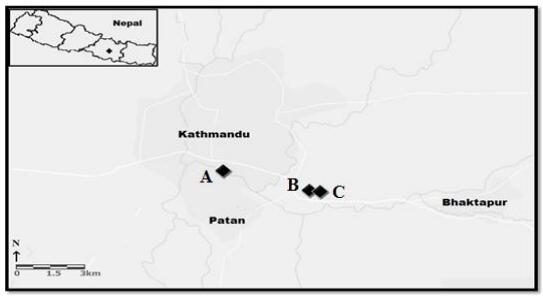
 DownLoad:
DownLoad: 